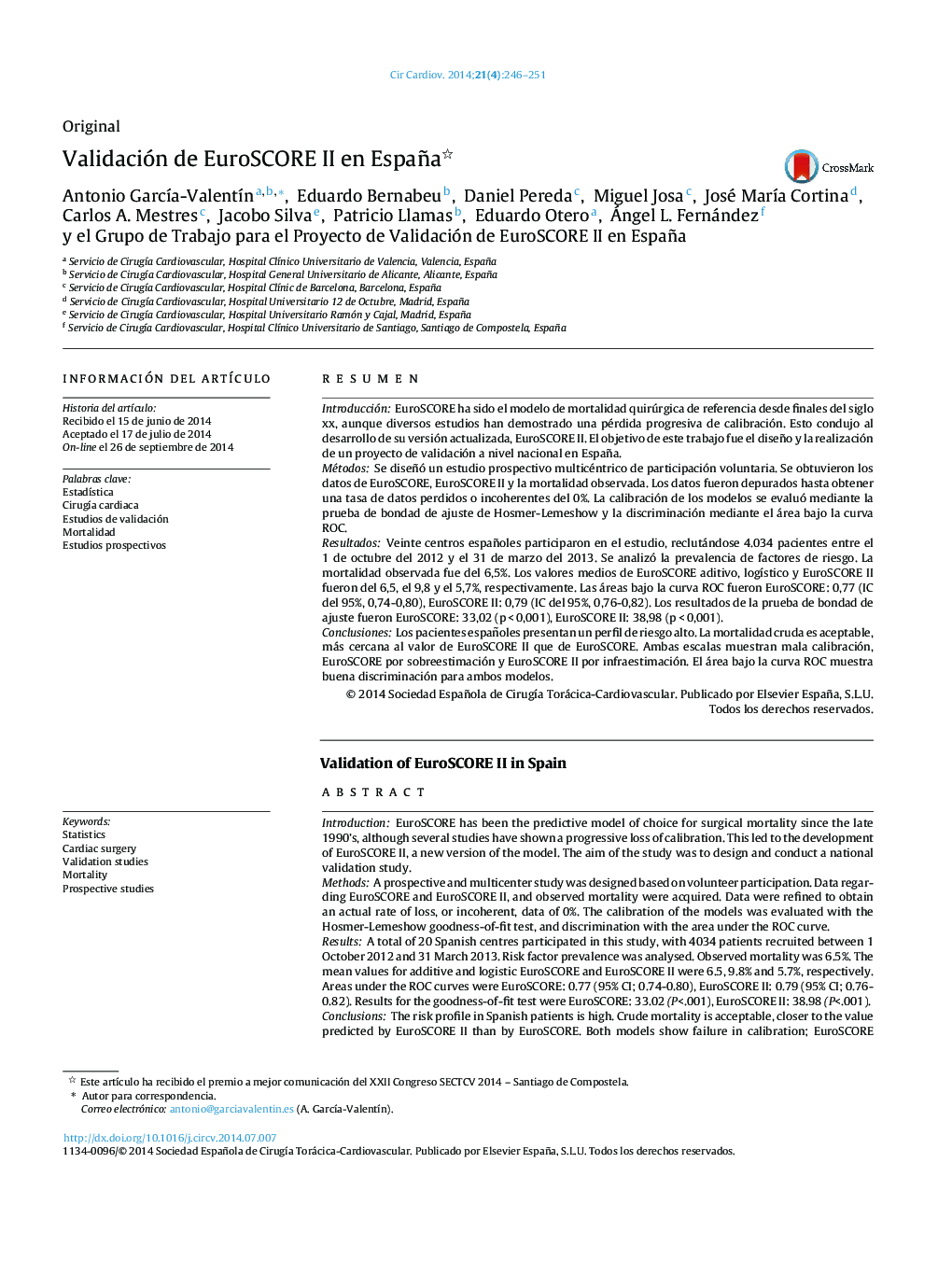| Article ID | Journal | Published Year | Pages | File Type |
|---|---|---|---|---|
| 2907607 | Cirugía Cardiovascular | 2014 | 6 Pages |
ResumenIntroducciónEuroSCORE ha sido el modelo de mortalidad quirúrgica de referencia desde finales del siglo xx, aunque diversos estudios han demostrado una pérdida progresiva de calibración. Esto condujo al desarrollo de su versión actualizada, EuroSCORE II. El objetivo de este trabajo fue el diseño y la realización de un proyecto de validación a nivel nacional en España.MétodosSe diseñó un estudio prospectivo multicéntrico de participación voluntaria. Se obtuvieron los datos de EuroSCORE, EuroSCORE II y la mortalidad observada. Los datos fueron depurados hasta obtener una tasa de datos perdidos o incoherentes del 0%. La calibración de los modelos se evaluó mediante la prueba de bondad de ajuste de Hosmer-Lemeshow y la discriminación mediante el área bajo la curva ROC.ResultadosVeinte centros españoles participaron en el estudio, reclutándose 4.034 pacientes entre el 1 de octubre del 2012 y el 31 de marzo del 2013. Se analizó la prevalencia de factores de riesgo. La mortalidad observada fue del 6,5%. Los valores medios de EuroSCORE aditivo, logístico y EuroSCORE II fueron del 6,5, el 9,8 y el 5,7%, respectivamente. Las áreas bajo la curva ROC fueron EuroSCORE: 0,77 (IC del 95%, 0,74-0,80), EuroSCORE II: 0,79 (IC del 95%, 0,76-0,82). Los resultados de la prueba de bondad de ajuste fueron EuroSCORE: 33,02 (p < 0,001), EuroSCORE II: 38,98 (p < 0,001).ConclusionesLos pacientes españoles presentan un perfil de riesgo alto. La mortalidad cruda es aceptable, más cercana al valor de EuroSCORE II que de EuroSCORE. Ambas escalas muestran mala calibración, EuroSCORE por sobreestimación y EuroSCORE II por infraestimación. El área bajo la curva ROC muestra buena discriminación para ambos modelos.
IntroductionEuroSCORE has been the predictive model of choice for surgical mortality since the late 1990's, although several studies have shown a progressive loss of calibration. This led to the development of EuroSCORE II, a new version of the model. The aim of the study was to design and conduct a national validation study.MethodsA prospective and multicenter study was designed based on volunteer participation. Data regarding EuroSCORE and EuroSCORE II, and observed mortality were acquired. Data were refined to obtain an actual rate of loss, or incoherent, data of 0%. The calibration of the models was evaluated with the Hosmer-Lemeshow goodness-of-fit test, and discrimination with the area under the ROC curve.ResultsA total of 20 Spanish centres participated in this study, with 4034 patients recruited between 1 October 2012 and 31 March 2013. Risk factor prevalence was analysed. Observed mortality was 6.5%. The mean values for additive and logistic EuroSCORE and EuroSCORE II were 6.5, 9.8% and 5.7%, respectively. Areas under the ROC curves were EuroSCORE: 0.77 (95% CI; 0.74-0.80), EuroSCORE II: 0.79 (95% CI; 0.76-0.82). Results for the goodness-of-fit test were EuroSCORE: 33.02 (P<.001), EuroSCORE II: 38.98 (P<.001).ConclusionsThe risk profile in Spanish patients is high. Crude mortality is acceptable, closer to the value predicted by EuroSCORE II than by EuroSCORE. Both models show failure in calibration; EuroSCORE by over-prediction and EuroSCORE II by under-prediction of surgical risk. Areas under the ROC curve show good discrimination for both models.
